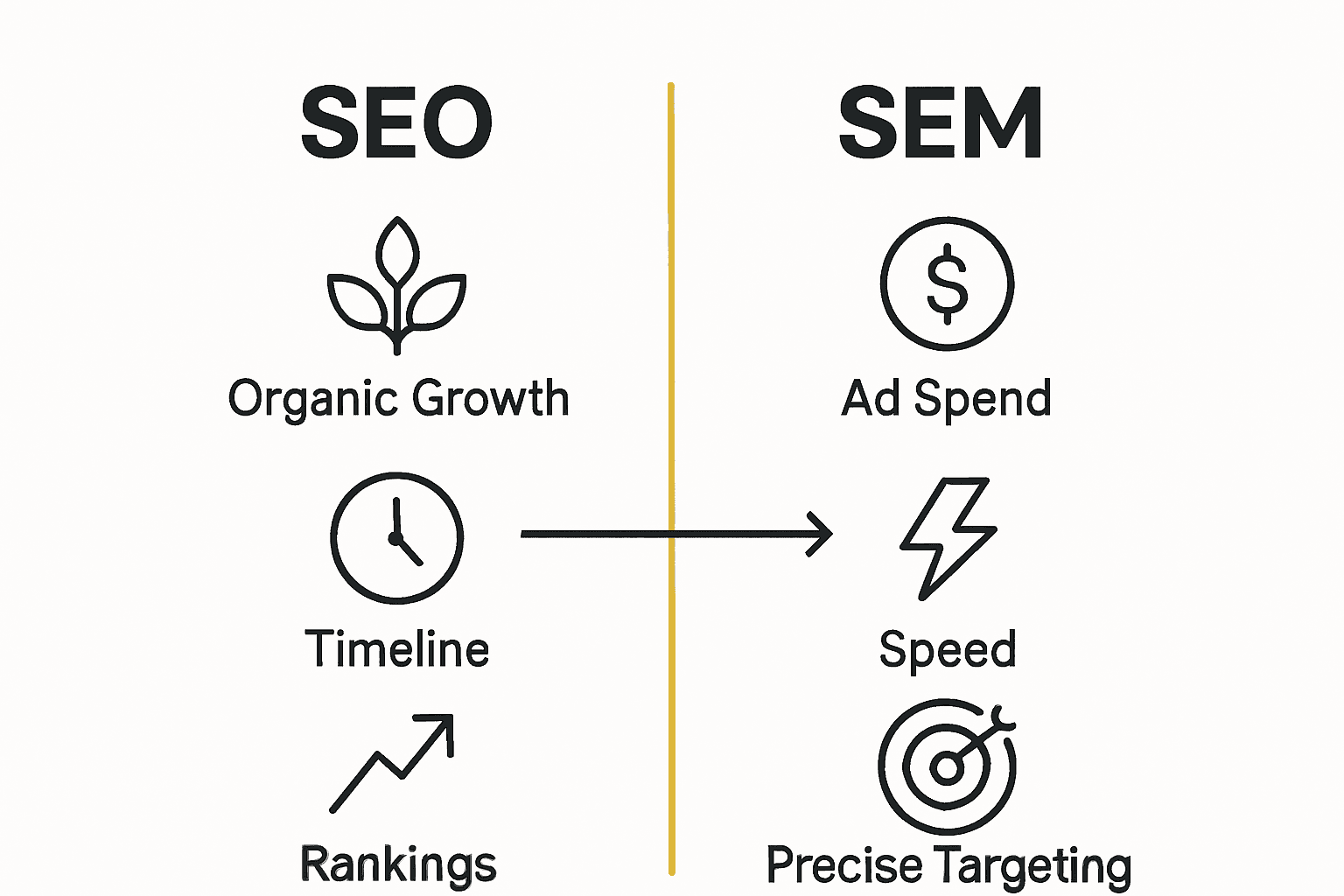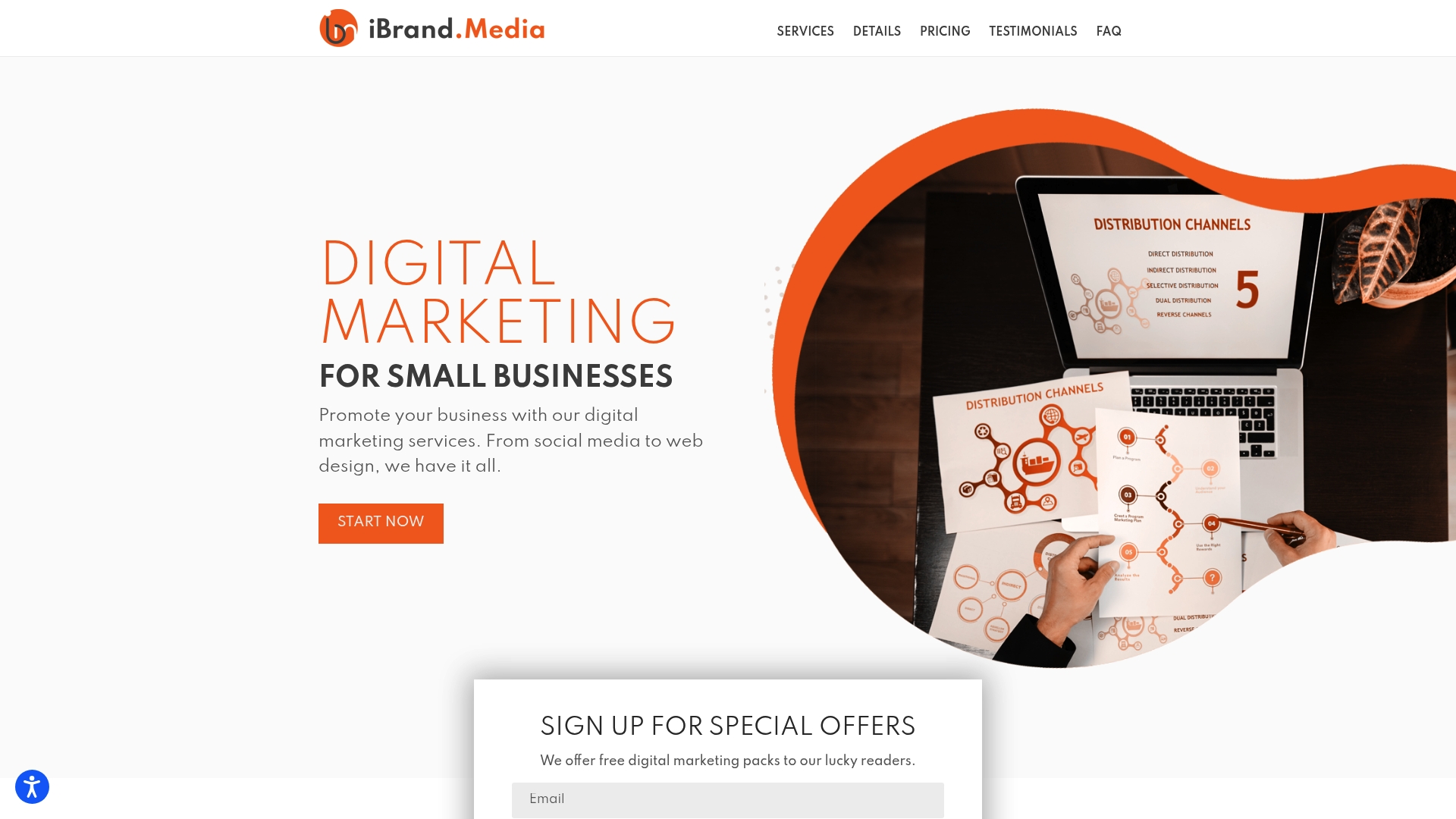Did you know that more than 90 percent of online experiences begin with a search engine? For anyone hoping to grow a business online, understanding the difference between SEO and SEM is crucial. Picking the right strategy can help your website climb search results and attract the right visitors. This guide highlights what sets these two tools apart and how each can impact your online growth.
Table of Contents
- Defining SEO and SEM in Digital Marketing
- Core Components of SEO versus SEM
- How SEO and SEM Strategies Differ
- Costs, Timelines, and Measurable Outcomes
- Choosing the Right Approach for Your Business
Key Takeaways
| Point | Details |
|---|---|
| SEO vs SEM | SEO focuses on organic strategies for long-term growth, while SEM combines paid ads for immediate visibility. |
| Cost Structure | SEO requires time and effort with no direct ad spend, whereas SEM involves ongoing financial investment. |
| Results Timeline | SEO delivers gradual results over 3-6 months, while SEM offers immediate results upon campaign launch. |
| Performance Metrics | SEO metrics include organic rankings and traffic, while SEM focuses on click-through rates and conversion efficiency. |
Defining SEO and SEM in Digital Marketing
Search Engine Marketing (SEM) and Search Engine Optimization (SEO) are two powerful strategies businesses use to improve their online visibility and attract potential customers. According to research from Coursera, Search Engine Marketing (SEM) is an internet marketing approach that combines paid advertising and search engine optimization techniques to increase a website’s visibility on search engine results pages (SERPs).
On the other hand, Search Engine Optimization (SEO) focuses specifically on optimizing a website to appear higher in organic (non-paid) search results. As explained by Maryville University, SEO involves strategic modifications to help websites rank naturally on search engine results without direct monetary investment. This means carefully crafting website content, improving site structure, and ensuring technical elements meet search engine algorithms’ requirements.
The key differences between SEM and SEO lie in their approach and cost structure:
- SEO: Organic strategy focused on long-term, sustainable growth
- SEM: Includes both organic optimization and paid advertising tactics
- Cost: SEO requires time and effort, SEM can involve direct advertising spend
For small business owners looking to boost their online presence, understanding why SEO matters in 2025 can provide deeper insights into developing an effective digital marketing strategy.
Core Components of SEO versus SEM
Search Engine Marketing (SEM) and Search Engine Optimization (SEO) represent two distinct yet interconnected approaches to improving online visibility. According to research from Coursera, SEM involves paid strategies like pay-per-click (PPC) advertising, where businesses directly pay to have their ads appear in search results. This approach provides immediate visibility by purchasing ad placements in search engine results pages.
In contrast, SEO focuses on organic optimization strategies that help websites naturally rank higher in search results. Research from Maryville University highlights that SEO strategies leverage detailed metrics about demographics and ideal customer profiles to craft web pages that optimize search presence without direct advertising spend. These efforts involve carefully developing content, improving website structure, and ensuring technical elements align with search engine algorithms.

The key components of each strategy differ significantly:
Here’s a comparison of the key components of SEO and SEM:

| Component | SEO | SEM |
|---|---|---|
| Strategy Type | Organic optimization | Paid advertising & organic optimization |
| Key Elements | Content optimization Keywords Technical SEO Backlinks |
PPC ads Targeted ad placements Ad campaigns |
| Cost Structure | Time & resources No direct ad spend |
Ongoing ad spend Per-click or per-impression costs |
| Timeline for Results | Gradual (3-6 months) | Immediate upon campaign launch |
| Metrics Tracked | Organic rankings Traffic Engagement |
CTR CPC Conversion rate |
SEM Components:
- Paid advertising campaigns
- Pay-per-click (PPC) ads
- Targeted ad placements
- Immediate visibility
- Metrics like click-through and cost-per-click
SEO Components:
- Content optimization
- Keyword research
- Technical website improvements
- Backlink development
- Long-term organic growth
For small business owners looking to understand the nuances of digital marketing, SEO vs Paid Advertising: Understanding Their Differences can provide deeper insights into selecting the right strategy for your business goals.
How SEO and SEM Strategies Differ
The primary distinction between Search Engine Optimization (SEO) and Search Engine Marketing (SEM) lies in their approach to gaining online visibility. According to research from Coursera, SEO is an organic strategy that focuses on optimizing website content and structure to naturally rank higher in search results without paying for direct ad placements. This approach requires consistent effort in creating high-quality, relevant content that search engines find valuable.
SEM, in contrast, is a paid advertising approach that provides immediate visibility through targeted ad placements. As explained by Maryville University, SEM strategies leverage metrics like bounce rate, click-through rate, and average cost per click to strategically position paid advertisements. While SEO builds credibility over time, SEM offers quick results by allowing businesses to purchase prime positions in search engine results pages.
Key differences between SEO and SEM include:
Cost Dynamics:
- SEO: Long-term investment with no direct advertising spend
- SEM: Requires ongoing financial investment for ad placements
Result Timelines:
- SEO: Gradual results, typically 3-6 months for significant impact
- SEM: Immediate visibility upon launching ad campaigns
Performance Tracking:
- SEO: Measured through organic ranking, traffic, and engagement
- SEM: Tracked via click-through rates, conversion rates, and ad spend efficiency
For small business owners seeking to understand the nuances of digital marketing, top SEO techniques for small business owners in 2025 can provide valuable insights into developing an effective online strategy.
Costs, Timelines, and Measurable Outcomes
Both Search Engine Marketing (SEM) and Search Engine Optimization (SEO) offer distinct approaches to measuring digital marketing performance, each with unique cost structures and outcome tracking methods. According to research from Coursera, SEM operates on a paid advertising model, where businesses directly invest in visibility through pay-per-click (PPC) campaigns. This approach allows for immediate, measurable results with transparent cost per acquisition and immediate traffic generation.
SEO, conversely, represents a long-term investment strategy that requires sustained effort and strategic content development. As explained by Maryville University, SEO strategies leverage detailed metrics like demographics and ideal customer profiles to craft webpages that organically improve search rankings. While the initial investment might seem higher in terms of time and resource allocation, the long-term benefits include sustained organic traffic and improved brand credibility.
Key Performance Metrics for Each Strategy:
SEM Metrics:
- Cost per click (CPC)
- Click-through rate (CTR)
- Conversion rate
- Immediate traffic generation
- Precise audience targeting
SEO Metrics:
- Organic search rankings
- Website traffic volume
- User engagement rates
- Backlink quality
- Content relevance scores
For small business owners looking to develop a comprehensive digital marketing strategy, how to set marketing goals for small business success in 2025 can provide additional insights into effectively measuring and achieving your online marketing objectives.
Choosing the Right Approach for Your Business
Selecting between Search Engine Marketing (SEM) and Search Engine Optimization (SEO) requires a strategic assessment of your business goals, budget, and immediate marketing needs. According to research from Coursera, SEM provides an immediate visibility solution for businesses seeking quick results, particularly those launching new products, promoting time-sensitive offers, or operating in highly competitive markets. Pay-per-click (PPC) advertising allows precise targeting and instant traffic generation with measurable outcomes.
SEO represents a more sustainable, long-term strategy that builds organic credibility and lasting online presence. As highlighted by Maryville University, SEO strategies leverage demographic insights and ideal customer profiles to craft content that naturally attracts and engages target audiences. This approach is particularly beneficial for businesses with limited advertising budgets seeking steady, consistent growth without continuous financial investment.
Consider These Factors When Choosing:
Choose SEM If You Need:
- Immediate visibility
- Quick campaign launches
- Precise audience targeting
- Short-term marketing goals
- Budget for direct advertising spend
Choose SEO If You Want:
- Long-term brand credibility
- Sustainable organic growth
- Cost-effective marketing
- Enhanced website authority
- Consistent audience engagement
For small business owners navigating digital marketing complexities, developing a digital marketing plan for small businesses in 2025 can provide comprehensive guidance in making informed strategic decisions.
Unlock the Power of SEO and SEM for Your Business Today
Understanding the differences between SEO and SEM can feel overwhelming when trying to decide the best way to boost your online presence and reach potential customers quickly. This guide highlights the challenges many businesses face such as choosing between organic growth and paid advertising while managing budgets and timelines. If you want real results without the guesswork you need a partner who knows how to tailor strategies for your unique needs.

At ibrand.media, we specialize in helping small to medium-sized businesses harness both SEO and SEM in ways that fit their goals and budgets. Our comprehensive approach covers everything from local marketing and web design to targeted ad campaigns and real-time performance tracking. Don’t wait months for growth or waste money on ineffective ads take advantage of smart, affordable digital marketing today. Discover how you can get started by exploring our Uncategorized category or visit our homepage to request a custom plan designed just for you.
Frequently Asked Questions
What is the main difference between SEO and SEM?
SEO focuses on organic optimization to increase website visibility in search results without direct monetary investment, while SEM combines both paid advertising and SEO techniques for immediate visibility in search engine results.
How do the costs differ between SEO and SEM?
SEO generally requires time and effort, with no direct advertising costs, whereas SEM involves ongoing expenditures for paid placements, such as pay-per-click (PPC) campaigns.
How long does it take to see results from SEO compared to SEM?
SEO typically requires a longer timeframe of 3-6 months to see significant results, while SEM can provide immediate visibility and traffic as soon as campaigns are launched.
What metrics are important for measuring the success of SEO vs SEM?
For SEO, key metrics include organic rankings, website traffic, and user engagement rates. In contrast, SEM metrics focus on click-through rates, cost per click, and conversion rates.
Recommended
- SEO vs Paid Advertising: Understanding Their Differences | Ibrandmedia
- Why Small Businesses Can’t Afford to Overlook Search Engine Marketing in 2025 | Ibrandmedia
- Why Small Businesses Can’t Afford to Overlook Search Engine Marketing in 2025 | Ibrandmedia
- Top SEO Techniques for Small Business Owners in 2025 | Ibrandmedia

Recent Comments